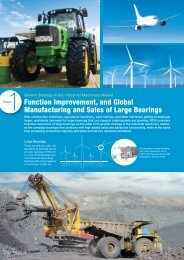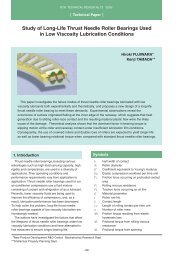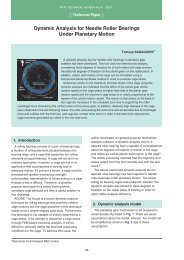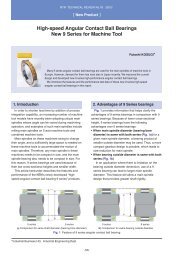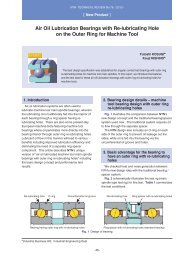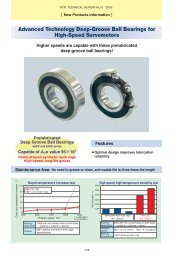Special Issue; Products for Industrial Machinery - NTN
Special Issue; Products for Industrial Machinery - NTN
Special Issue; Products for Industrial Machinery - NTN
You also want an ePaper? Increase the reach of your titles
YUMPU automatically turns print PDFs into web optimized ePapers that Google loves.
<strong>NTN</strong> TECHNICAL REVIEW No.742006<br />
Photo 2 Example of test pieces after evaluation (occurred split and crack)<br />
The result of evaluation <strong>for</strong> base oils used on<br />
bearings and typically used resin materials is<br />
summarized in Table 7.<br />
Table 7 Results of chemical attack test<br />
Ester oil Fluorine oil Mineral oil PAO<br />
ABS<br />
<br />
PC<br />
<br />
POM<br />
<br />
PA<br />
<br />
PBT<br />
<br />
PEEK <br />
PPS<br />
<br />
The oil does not attack the resin much.<br />
In certain cases, the oil attacks the resin.<br />
The oil attacks the resin.<br />
Color copying machines and color LBPs incorporate<br />
many components made of ABS (acrylonitrilebutadiene-styrene)<br />
and PC (polycarbonate).<br />
There<strong>for</strong>e, the grease prefilled in bearings and the rust<br />
preventive oil must be oils that do not have chemical<br />
attack effects on resin materials.<br />
Based on the chemical attack results of the<br />
evaluation described above, <strong>NTN</strong> is using greases<br />
and rust preventive oils that employ PAO and fluorine<br />
oils as their base oils. Additionally, the conductive<br />
greases previously described in Sec. 4.2 are also<br />
types that do not cause chemical attacks.<br />
4.3 Fuser roller support bearings that prevent<br />
frictional noise<br />
On the fuser roller support bearings, the fit between<br />
the inner ring and the shaft is loose to simplify the<br />
assembly work. Subjected to heat and load, the fuser<br />
roller is affected by both thermal expansion in the axial<br />
direction and bending. Due to the loose fit, the thermal<br />
expansion in the axial direction and the bending, the<br />
attitude of the roller is disturbed, the inner ring hits the<br />
shaft and, as a result, frictional noise occurs at a<br />
frequency of once per revolution. Previously, to control<br />
this problem, grease or a resin sleeve (heat-insulating<br />
sleeve) was placed between the shaft and the inner<br />
ring.<br />
Through a special lubricating surface treatment on<br />
the bore surface of the inner ring, <strong>NTN</strong> has succeeded<br />
in decreasing the friction coefficient on the bore<br />
surface of the inner ring by 40%. As a result, the<br />
attitude of the inner ring is not disturbed in spite of the<br />
thermal expansion and bending on the fuser roller,<br />
and the inner ring can follow the motion of the roller,<br />
thereby frictional noise that would occur otherwise is<br />
prevented.<br />
The result of the durability evaluation of the special<br />
lubricating surface treatment on the bore surface of<br />
the inner ring is shown graphically in Fig. 8. After the<br />
elapse of 600 operating hours under the test<br />
conditions summarized in Table 8, there was virtually<br />
no change in the inner ring bore diameter, and it is<br />
apparent that wear did not occur on the treated<br />
surface.<br />
Table 8 Test condition of wear test <strong>for</strong> special lubricant film<br />
Test bearing<br />
Bearing temperature (˚C)<br />
Running speed (min -1 )<br />
Radial load (N)<br />
Shaft material/<br />
surface roughness<br />
Variation in dimension m<br />
3<br />
2<br />
1<br />
0<br />
-1<br />
-2<br />
Test conditions<br />
2TS3-6804ZZ 20mm32mm7mm<br />
200<br />
120<br />
294<br />
A5052Ra0.5<br />
-3<br />
0 100 200 300 400 500 600 700<br />
Test duration h<br />
Fig. 8 Results of wear test <strong>for</strong> special lubricant film<br />
-66-



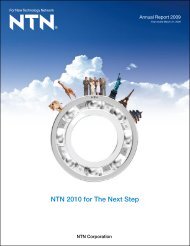
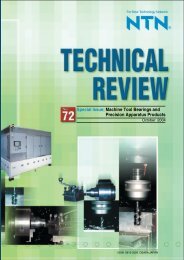
![[New Product] Unit Products for Office Equipment - NTN](https://img.yumpu.com/27154451/1/184x260/new-product-unit-products-for-office-equipment-ntn.jpg?quality=85)
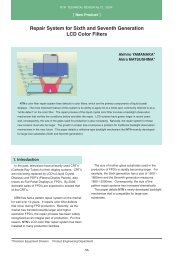
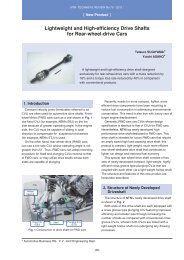
![[New Product] Development of Oil-impregnated Sintered ... - NTN](https://img.yumpu.com/27154427/1/184x260/new-product-development-of-oil-impregnated-sintered-ntn.jpg?quality=85)

